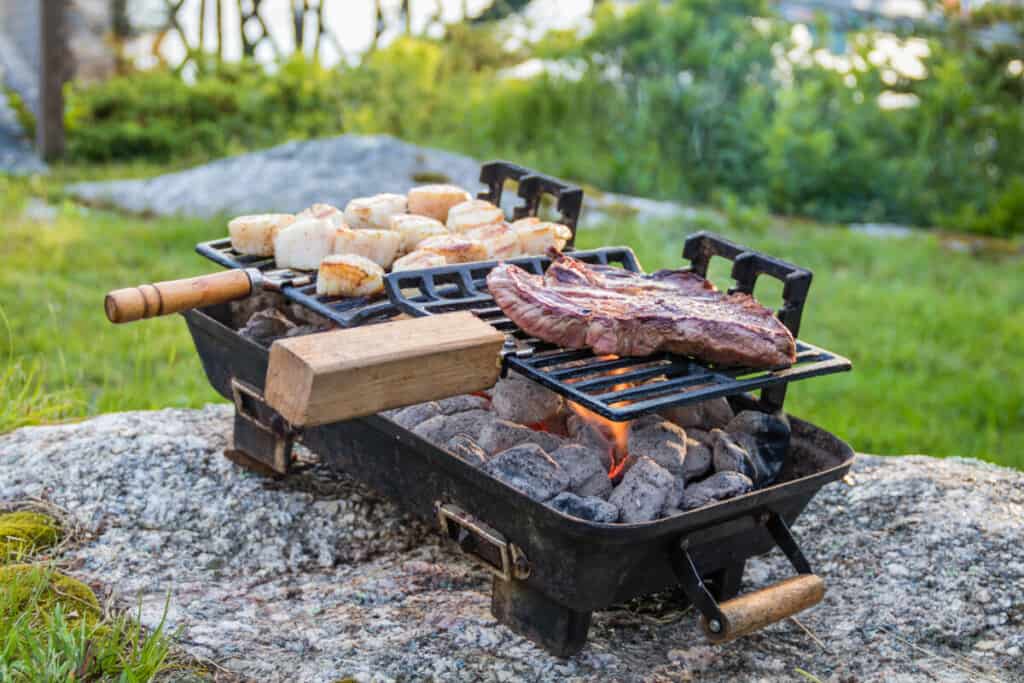
Small in Impact Big in Flavour: Your Guide to Hibachi Grilling
With the hot days of summer already upon us, you’re probably more chuffed than a dog with a bone to start grilling. Well, this summer, why not try something different? A new way to cook and entertain at the same time, from the convenience of your own home. From the Land of the Rising Sun to the Land Down Under—there’s an increasingly popular type of grill sizzling all over Oz backyards. If you’re one for Japanese food, you’re in for a treat because things are about to get ekisaitingu.
It all starts with the term Hibachi, a traditional Japanese heating device from the Heian period. Essentially a fire bowl, this open-top container held burning charcoal for the sole purpose of heating a room, or boiling water. Wait a minute… How come there are so many Hibachi restaurants in Australia? Well, the thing is that outside of Japan, this term has adopted several other meanings.
Contents
What Does Hibachi Mean in Food?
Those fond of Japanese-style cuisine may use this term to refer to the cooking style, the grill itself, and the type of restaurant serving yaki—food cooked over direct heat. Speaking in terms of the cooking style, this UwU-sounding word to non-native ears describes the traditional techniques employed to prepare seafood, meat and veggies. However, when it comes to the grill itself, it’s where it gets tricky.
If you’re considering buying a Hibachi grill what you actually need is a Konro or Shichirin. These purpose-built appliances are the small, portable, charcoal-fired grills, used to cook a variety of authentic Japanese dishes. For an added bit of razzle-dazzle, there’s also the word Teppan which translates to an iron plate used to cook food.

If you’ve ever been to a Japanese steakhouse (outside of Japan, that is), where the chef prepares the food right in front of you, you’ve been to a Hibachi-style restaurant, or as many would argue, a Teppanyaki restaurant. As for me personally, Hibachi translates to yum. Fight me if you will, but there’s no denying that this little grill adds a whole new dimension to BBQing.
Is Hibachi Food Delicious?
Grilled over direct heat, Hibachi food cooks much quicker, retaining more of its natural flavour. Sorry colonel, there’s a new sheriff in town, and he goes by the name Yakitori. Bursting with mouth-watering, smoky flavour, Yakitori, a type of skewered chicken, is one of the most popular foods you can order, or prepare yourself on a traditional Japanese portable grill.
But don’t get it twisted, these small and compact grills are as versatile as they come, meaning you can cook a range of foods other than chicken. From beef, shrimp and fish, to side dishes such as eggs, veggies, rice and the like—the options are endless.
Is Hibachi Food Healthy?
Good for your taste buds, but what about your health? One of the greatest benefits of grilling food using an open flame is that there’s no need to smother it in unhealthy fats and oils for flavours to develop. But other than that, it all comes down to what you eat and how you prepare it. Remember, even the leanest of meats and vegetables can turn unhealthy when loaded with sauces and cheese. If you’re all about that flavour without the added calories, stock up on spices such as garlic powder and paprika.

How to Use This Japanese Grill?
For an authentic Japanese grilling experience, you’d want to get your mitts on Binchotan charcoal a.k.a the King of charcoals. Prized for its clean and long-burning properties, Binchotan is odourless while burning, up until you add meat on the grill—and that’s when the magic happens. Once the juices hit the charcoal, the Binchotan slowly fills the air with a delicious, enticing aroma, bound to get your tummy growling. The final result? Unmistakeably tender and juicy BBQ with heightened, natural flavour.
Can Hibachi Grills Be Used Indoors?
Although you can find modern, electric Japanese-inspired BBQs suitable for cooking indoors, the charcoal-fired grills are reserved for alfresco and restaurant kitchens under appropriate conditions. Is it really that bad if you grill indoors? Even in the Heian period, the traditional fire bowls were used in well-ventilated areas. Charcoal-fired grills should never be used in airtight rooms where the risk of carbon monoxide poisoning is high.
Don’t let that discourage you, though. These grills are incredibly space-efficient and functional. Regardless of how big or small of a backyard you may have, Konro grills can fit seamlessly into virtually any alfresco setup.

Is a Hibachi Grill Worth It?
If you’re one with a soft spot for Japanese cuisine or just enjoy cooking for the masses, you’re going to love this small charcoal grill. Still, wondering why? Here’s a quick list to sum everything up:
- Compared to conventional and in-built barbecues, it’s very affordable.
- It’s portable, so you can take the BBQ party anywhere.
- It’s small and compact, ideal for backyards where space is at a premium.
- It’s low-maintenance and durable, you’ll use it for years to come.
- Binchotan is an eco-friendly and efficient way to grill. Not only does it burn longer, but it’s also reusable.
- The cooking is quick and easy.
- The food is absolutely delicious.
- Everyone wants to gather around the grill.
Dreaming of building the ultimate outdoor retreat for cooking and entertaining? If so, don’t think twice—add to cart.
Closing Thoughts
Now that you know a bit more about traditional Japanese grills, you can explore some of the authentic BBQs that have reached our shores. They’re available in several sizes, ranging from small 2-person grills, to large for parties of 6+ people, so finding the perfect one won’t be a hassle.
Love eating, but you aren’t big on cooking? Fret not, you can still enjoy an immersive tabletop grilling experience in one of Australia’s Japanese restaurants. With that being said, I’ll leave you to it!

